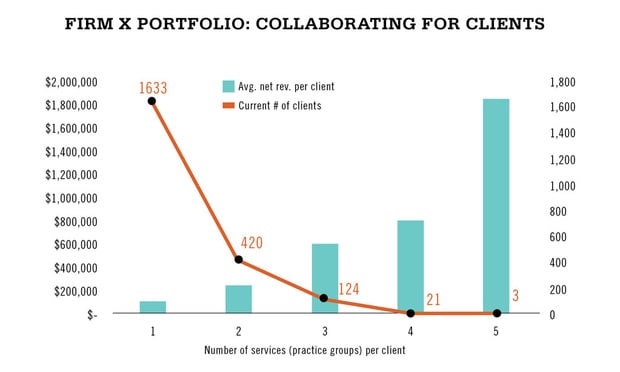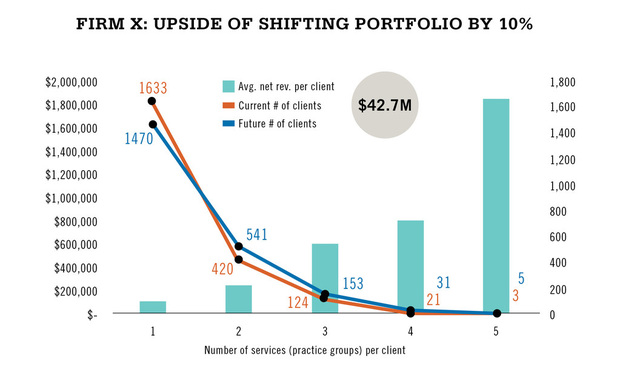By Failing to Collaborate, Law Firms Are Leaving Money on the Table
Firms are letting down clients and losing revenue.
October 04, 2018 at 04:56 PM
12 minute read

Under pressure to develop deep expertise as a way to differentiate themselves in a crowded legal arena, many lawyers have focused more and more on a narrow aspect of the law—data privacy for financial institutions in the E.U., say, or public-private partnerships in the transportation sector. Like law firms themselves, clients are facing a world that is increasingly volatile, uncertain, complex and ambiguous. Clients need outside counsel that can collaborate to solve their problems, but law firms' increased specialization creates an unfortunate conflict, and many are leaving big money on the table as a result.
When firms get collaboration right—that is, do complex work for clients that spans practices and offices within the firm—they earn higher margins, inspire greater client loyalty, gain access to more lucrative clients and attract more cutting-edge work. Empirical research, based on millions of data records, including time sheets, billing records and personnel files across dozens of global firms, provides the quantitative evidence. This form of integrated client service, which often crosses practice groups and other silos, is what I call smart collaboration. It requires a radically more sophisticated approach than the self-serving cross-selling tactic that a lot of managing partners implore their lawyers to engage in.
The problem is that most firms have carved up their highly specialized, professional experts into narrowly defined practice areas, and collaborating across these silos is often messy, risky and costly. Even when partners recognize the need for greater collaboration in their firm to drive growth, their intellectual buy-in doesn't translate to behavioral change. They worry that a short-term reward system makes collaboration a fool's errand. Or, even if they see the benefits, they simply don't know how to get started or how to prioritize the myriad prospects.
This article provides a starting point. Using data from across multiple firms, we show how cross-practice collaboration can provide significant revenue uplift—and outline how firms can analyze their existing data to see whether they're reaping the full potential. Our benchmarks suggest that most firms could increase revenues by 5 to 12 percent by shifting their portfolio of service. We also show examples where firms aren't currently realizing collaboration's benefit. Here, we provide direction for how leaders can interrogate their results to understand why they are underperforming their potential.
The Upside of Collaboration
Clients care about the quality of partner-to-partner collaboration because it's the best way to get efficient, high-quality, customized counsel on a host of issues. But we also know that they push back on bills that have “team meeting” as a line item. So are they really willing to pay?
Our data—and most likely yours—confirms it. Firms whose lawyers develop the confidence and capabilities to open conversations with their clients about how to add value through collaboration are winning more loyal clients and greater profits. But when we run the numbers for many firms, their leaders are surprised by the results.
The first step to understanding your data is to analyze your current client portfolio to determine the average revenues for each group of clients that are served by the same number of practice groups. In one firm, we saw that revenues were 5.7 times higher for clients served by three practice groups than by a single one. Those clients served by five practice groups generated fees 17.6 times higher than those with just one kind of service.
We have found this typical pattern across dozens of law firms—and other kinds of professional firms, such as Big Four accounting firms, boutique consultancies and financial institutions. Perhaps even more important is the direct correlation between client longevity and the number of practice groups involved. While 75 percent of clients working with a single partner would consider switching firms if that partner left, 90 percent of clients served by two or more partners would remain loyal to their firm under the same circumstances. These numbers indicate that revenues don't just multiply as a result of effective collaboration; they become significantly more sustainable.
When Collaboration Doesn't Work
Just because multiple practice groups are billing a client doesn't mean that they're actually collaborating. In one firm we studied, for instance, the leaders were initially quite pleased because their business development team had generated a list showing that a range of clients within their top 200 were served by up to eight of the firm's practice groups. When we ran the analysis to see how much revenue those initiatives were producing, however, the numbers were shocking: for clients served by three practice groups, fees were a paltry 1.5 times higher than for clients served by a single group, meaning each group was effectively generating far less than it would serving a client solo.

If you've analyzed your data and it doesn't demonstrate the uplift you're looking for, there are ways to interrogate the situation and try to find out what's going wrong.
- Are the clients served by multiple practice groups actually served separately by each of these practice groups rather than teaming up to solve more complex matters? In an ideal collaborative scenario, the whole should be more than the sum of the parts. If it is less, you know your practice groups are working individually.
- If you can identify good examples of practice group collaboration, are your teams pricing their efforts correctly? Billing clients for only the sum total of each group's effort ignores the value-add and synergies provided by smart collaboration.
- Is there a realization problem? You might be attempting to bill higher fees, but clients could be pushing back on those figures because you're tackling the wrong problems, passing unnecessary costs onto the client or being otherwise ineffective.
If you suspect you're faced with any of these scenarios, analyze the data in order to clearly identify the problem. Ultimately, you need to reach out to the client to find an appropriate solution together.
Money on the Table
Even firms that have figured out how to use collaboration to provide the best service to clients—and get paid accordingly—aren't optimizing collaboration across their portfolios. Unlike the Big Four or the high-end consulting firms that have sophisticated client development strategies, most law firms have a laissez faire approach to their portfolios. The largest clients have grown up over time, based on the efforts of a small set of partners, without explicit direction or prioritization from the firm.
By my estimation, at least 70 percent of large global law firms today include collaboration-related goals in their strategic plans. But many of these same firms lack a solid understanding of how collaboration is working across their portfolios and where the gaps are. Simply put, you can't just state that collaboration matters and hope lawyers change their behavior. You need to set specific objectives, based on a deep understanding of your data and its implications, then hold people accountable for delivering.
After you analyze your financial records to understand how well collaboration is paying off, the next step in setting and implementing a collaboration-based strategy is understanding your current portfolio. You've classified clients by the number of practice groups serving each one. Now, count how many clients are in each of those groups. Inevitably, you will find many more clients served by fewer practices. Is the mix right?
Visualizing data is very important. Even highly numerate people who are trained in quantitative analysis have an easier time spotting trends and grasping implications when they can see the findings. For the firm used as an example earlier, by graphing its portfolio onto revenue, it's clear that the number of clients served decreases sharply as the number of practice groups increases.

This overall decline is expected, but should it drop by three-quarters with each successive step along the collaboration path? Most firms' strategies rest on the belief that a number of clients would value being served by a broader mix of services. Chances are, you're leaving money on the table.
To see how much, try this analysis: How much is it worth if you shift just 10 percent of clients in each category to the next category? For this firm, it adds up to nearly $43 million. That's an 11 percent increase in the firm's total revenue.

This figure is pretty typical across the firms we studied that are collaborating well—that is, doing complex work for clients that results in appropriate levels of increased revenue. In general, firms are missing out on an additional 5 to 12 percent of overall revenue by not figuring out how to make this shift.
How to Get Started
The obvious place to introduce this 10 percent shift is among the clients getting the most collaboration out of the firm, a group of dozens or fewer, rather than the hundreds using fewer practice groups. Strategically, you want to focus on this high-worth portion of your portfolio simply because adding additional practice groups at this level is worth such a significant chunk of revenue. And on the client side, these individuals are already spending a lot of money on your legal services, indicating that they have a high level of trust in your lawyers and belief that collaboration makes sense for them.
Achieving a shift at the top end of your portfolio hinges on having a leader who is accountable for delivering uplift. It's vital that everyone on your teams feels like they'll be recognized and rewarded for bringing in the next practice group. Each lawyer must recognize that their job is finding legitimate ways to service a client, rather than throwing random partners and practice groups at them (the dreaded cross-selling tactic that clients abhor).
Deciding which high-end clients deserve the most resources requires careful strategizing. Your data should tell you which clients are producing the highest margins, which is obviously a critical consideration beyond top-line revenue. Your relationship partner should also be able to tell you about opportunities and competitors' vulnerabilities with clients. For example, which incumbent firm is providing service now in areas that are white space for you? How long has that relationship been in place? To effectively implement smart collaboration and deepen these high-value client relationships, you must figure out ways to unlock value that your firm can provide given how deeply embedded you are in the client's current work.
All of this doesn't mean that the firm should neglect the hundreds of smaller opportunities for collaboration. Working with the lower end of the scale allows you to create a grassroots culture of frontline collaboration. To optimize the number of people at your firm operating on a strategic level, building collaborative skills in the junior partners that are handling smaller projects is a worthwhile investment. In this sense, smaller firms also represent enormous upside potential.
But among the hundreds of firms that you're trying to shift from being served by one practice group to two, how do you decide which 10 percent to shift? You can't hope that people will just catch the bug and take steps in the right direction; for most people, these actions feel too foreign and risky. You need to make clear, deliberate choices to focus resources and build accountability. Using three specific criteria to choose these smaller firms is a good first step.
- Locate potentially big clients that are only getting served by one practice group—you're only getting a portion of their legal spend, so prioritize those where you currently have a small portion.
- Find clients currently being served by a single practice group that has an obvious companion. Make sure you're adding value in this scenario; the point is not to simply shove another practice at an unwitting client.
- Do you have a junior partner who's keen to learn to collaborate? Pairing them with a more experienced practice group leader may help them develop their collaborative skills.
As with shifts on the other end of the collaboration spectrum, accountability and motivation are key. You don't have to use direct pay increases in order to motivate your teams; in fact, making sure your firm's leaders model the behavior you want to inspire is often a more effective method.
The CEO of Dechert, Henry Nassau, created a collaboration-focused contest. He identified 10 high-potential clients that were currently served by only a single practice group, and challenged the firm's lawyers to help generate a material amount of work for another group in the firm. “I dipped into my own pocket to buy the winning team a prize,” Nassau says. In this case, attention from the chair was far more important than the award itself, and the healthy competition among partners created a real buzz in the firm.
Anthropologists will tell you that culture is composed of stories—when your leaders create these stories by acting as role models, they embed collaboration as a pillar of firm culture.
Heidi Gardner is a distinguished fellow at Harvard Law School's Center on the Legal Profession. She teaches leadership and collaboration in Harvard Law School's Executive Education programs for law firm partners.
This content has been archived. It is available through our partners, LexisNexis® and Bloomberg Law.
To view this content, please continue to their sites.
Not a Lexis Subscriber?
Subscribe Now
Not a Bloomberg Law Subscriber?
Subscribe Now
NOT FOR REPRINT
© 2025 ALM Global, LLC, All Rights Reserved. Request academic re-use from www.copyright.com. All other uses, submit a request to [email protected]. For more information visit Asset & Logo Licensing.
You Might Like
View All

Three Akin Sports Lawyers Jump to Employment Firm Littler Mendelson

Brownstein Adds Former Interior Secretary, Offering 'Strategic Counsel' During New Trump Term
2 minute read
Trending Stories
Who Got The Work
J. Brugh Lower of Gibbons has entered an appearance for industrial equipment supplier Devco Corporation in a pending trademark infringement lawsuit. The suit, accusing the defendant of selling knock-off Graco products, was filed Dec. 18 in New Jersey District Court by Rivkin Radler on behalf of Graco Inc. and Graco Minnesota. The case, assigned to U.S. District Judge Zahid N. Quraishi, is 3:24-cv-11294, Graco Inc. et al v. Devco Corporation.
Who Got The Work
Rebecca Maller-Stein and Kent A. Yalowitz of Arnold & Porter Kaye Scholer have entered their appearances for Hanaco Venture Capital and its executives, Lior Prosor and David Frankel, in a pending securities lawsuit. The action, filed on Dec. 24 in New York Southern District Court by Zell, Aron & Co. on behalf of Goldeneye Advisors, accuses the defendants of negligently and fraudulently managing the plaintiff's $1 million investment. The case, assigned to U.S. District Judge Vernon S. Broderick, is 1:24-cv-09918, Goldeneye Advisors, LLC v. Hanaco Venture Capital, Ltd. et al.
Who Got The Work
Attorneys from A&O Shearman has stepped in as defense counsel for Toronto-Dominion Bank and other defendants in a pending securities class action. The suit, filed Dec. 11 in New York Southern District Court by Bleichmar Fonti & Auld, accuses the defendants of concealing the bank's 'pervasive' deficiencies in regards to its compliance with the Bank Secrecy Act and the quality of its anti-money laundering controls. The case, assigned to U.S. District Judge Arun Subramanian, is 1:24-cv-09445, Gonzalez v. The Toronto-Dominion Bank et al.
Who Got The Work
Crown Castle International, a Pennsylvania company providing shared communications infrastructure, has turned to Luke D. Wolf of Gordon Rees Scully Mansukhani to fend off a pending breach-of-contract lawsuit. The court action, filed Nov. 25 in Michigan Eastern District Court by Hooper Hathaway PC on behalf of The Town Residences LLC, accuses Crown Castle of failing to transfer approximately $30,000 in utility payments from T-Mobile in breach of a roof-top lease and assignment agreement. The case, assigned to U.S. District Judge Susan K. Declercq, is 2:24-cv-13131, The Town Residences LLC v. T-Mobile US, Inc. et al.
Who Got The Work
Wilfred P. Coronato and Daniel M. Schwartz of McCarter & English have stepped in as defense counsel to Electrolux Home Products Inc. in a pending product liability lawsuit. The court action, filed Nov. 26 in New York Eastern District Court by Poulos Lopiccolo PC and Nagel Rice LLP on behalf of David Stern, alleges that the defendant's refrigerators’ drawers and shelving repeatedly break and fall apart within months after purchase. The case, assigned to U.S. District Judge Joan M. Azrack, is 2:24-cv-08204, Stern v. Electrolux Home Products, Inc.
Featured Firms
Law Offices of Gary Martin Hays & Associates, P.C.
(470) 294-1674
Law Offices of Mark E. Salomone
(857) 444-6468
Smith & Hassler
(713) 739-1250









